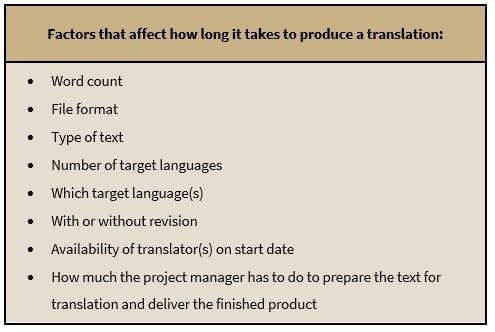
The world of business runs on deadlines. In our industry, the time available to produce translations depends on when the text is supplied by the client and when they need to publish it – sometimes, when asked when they need it back, the answer is “yesterday”. But how long does a translation actually take, and what factors are involved?
The documentation, the advertising brochure, the new software or the website you’ve been sweating away at for months is finally finished. “All” that’s left is the translation – and sometimes there’s not much time before it needs to be ready. It happens! As a translation agency, we and our translators pull out all the stops to meet deadlines (no matter how tight) and deliver translations when our clients need them. But it takes a certain amount of time to produce a high-quality translation, and even longer if it needs to be reviewed as well.
So how long does a translation take?
It’s hard to give a time frame that will apply for all translations, as it depends on various factors. But we’ll try anyway:

© MEINRAD
Say you need a translation of a one-page Word file from English to German. Taking into account all the steps in the process, for a non-urgent translation without review a realistic deadline is 24 hours from receipt of the job. But jobs rarely involve translating one-page Word documents into just one language (and a common language to boot). And that’s when it gets harder to estimate how long a translation will take – because the translation itself is just the tip of the iceberg. Let’s begin at the beginning:
How 21st century translation agencies work
You might think a translation agency sends the files it receives from the client as they are to the translator, the translator works on them in that format, and then the finished file is sent straight back to the client – but that isn’t the case anymore. These days translation agencies work with CAT tools, which the project manager uses to prepare everything before assigning the text to the translator in order to ensure a smooth translation process. Depending on the file format and word count, this preparation process can take anything from matter of minutes (as it would in the above example) to several hours or even days. PDF files, for instance, need to be converted before translation and re-configured afterwards, which usually takes a not inconsiderable amount of time.
Only once the files have been imported into the CAT tool, the text has been pre-translated using the translation memory and the word analysis has been carried out can the agency contact the appropriate translator to ask if they’re available. The more languages a project comprises, the more time it will take for the project manager to prepare the project.
The translators
It can then take a bit more time before all the translators have confirmed their availability and accepted the job. As freelancers, translators usually don’t have fixed working hours like salaried employees – and of course they have a personal life, so they’re not in front of their computer all the time. Some are early birds and some are night owls, some have families and children to look after, some are interpreters in addition to being translators, and they all have things to do, places to be and people to see. In short: they won’t always be able to respond and accept the job immediately.
Most of the time, translators already have enough work to be getting on with. That means they’ll be working on other projects when a new job comes in, so they won’t always be able to start the new job straight away – though if need be, many translators will drop everything and put in an extra shift to help clients meet their tight deadlines. And remember that they may be unable to accept the job, in which case the project manager needs to look for another translator.
Language and time zone
Another factor that affects how quickly clients get their translations is the language(s) involved. If common languages are required, the translation agency can usually call on lots of freelance translators (or even its own In-House Linguists), making it highly likely that the translation can be delivered quickly. But if other, less common languages are required, there won’t be as many translators available – and potentially even fewer with the necessary specialist expertise. Translators of more exotic languages also tend to live in different time zones, so sometimes all the agency can do is wait until they’re awake.
The translation itself
Once a translator starts work on a project, they can translate between 2000 and 3000 words a day. This is a rough figure which depends heavily on how “suitable for translation” the text is and on the translator’s experience in the respective field or with the particular client’s texts. Simple continuous text is quicker to translate than software interface texts without any context, for instance, or specialist texts requiring lots of research and specific vocabulary. And core translators offer a real benefit: translators who have worked on a client’s texts for many years will know their terminology like the back of their hand, which will reduce the amount of time they need.
With a review?
Clients may also request a review. An ISO 17100 review is an additional step in which a second translator reviews the translation by checking it against the source text – which means another person the project manager needs to deal with. And the reviewer often won’t be able to begin their work the minute the translator is finished, so even though a reviewer can get through more words per day than a translator, the amount of additional time that needs to be factored in can be substantial.
Final checks carried out by the project manager
Once the translator (and reviewer) have used their specialist expertise to complete their work with the necessary care and attention, the project manager gets involved again. They run a computer-aided quality assurance check, export the files from the CAT tool and look over the finished files, which may involve making minor layout adjustments or resolving various other issues. Only then are the translations delivered to the client.
With all these factors to take into account, it should now be no surprise when a project manager reacts to the question “How long does a translation take?” by hesitating and then saying “It depends...”
Main image: © Storyblocks

